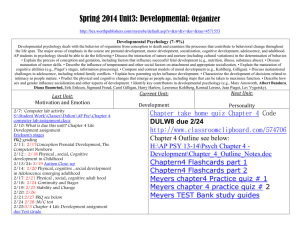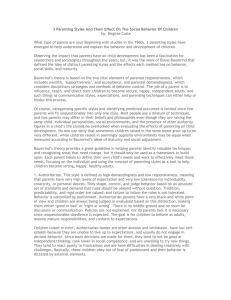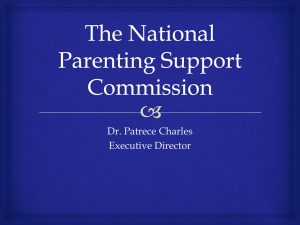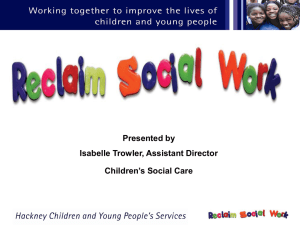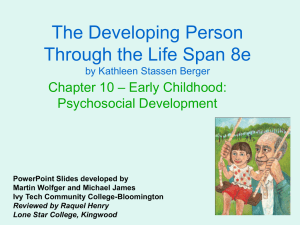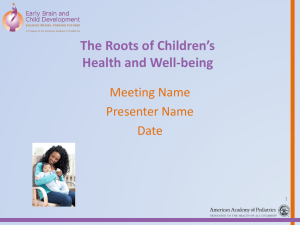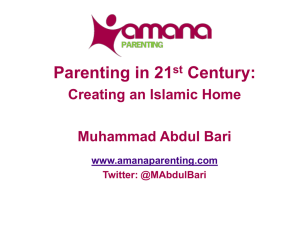The last style of parenting is identified as uninvolved
advertisement
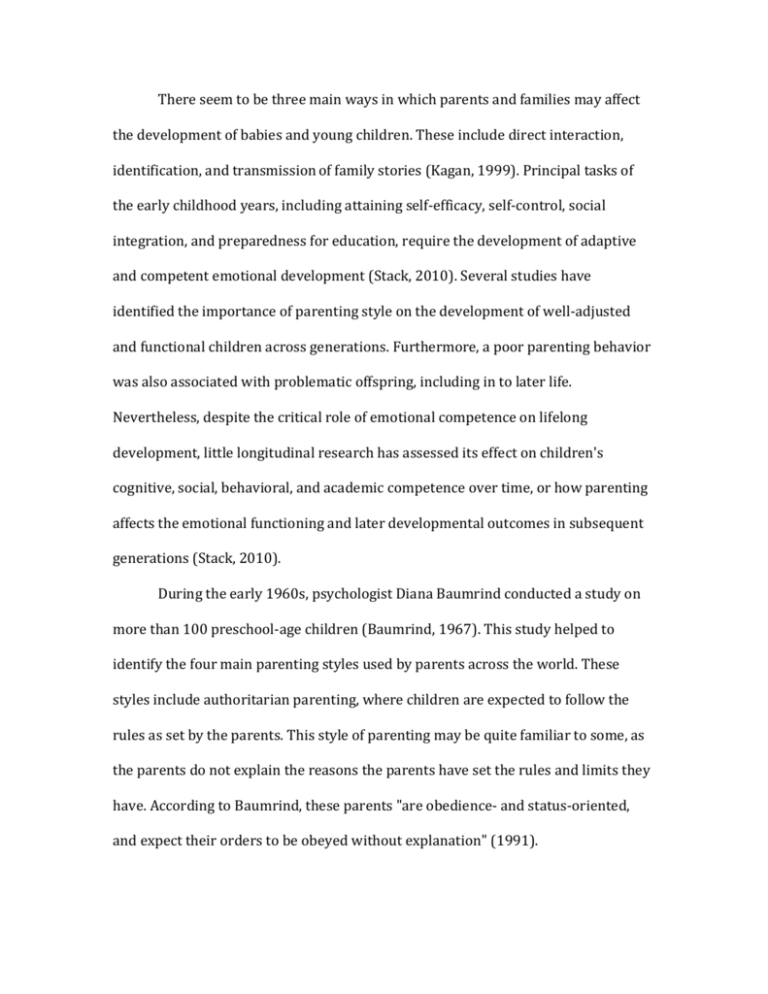
There seem to be three main ways in which parents and families may affect the development of babies and young children. These include direct interaction, identification, and transmission of family stories (Kagan, 1999). Principal tasks of the early childhood years, including attaining self-efficacy, self-control, social integration, and preparedness for education, require the development of adaptive and competent emotional development (Stack, 2010). Several studies have identified the importance of parenting style on the development of well-adjusted and functional children across generations. Furthermore, a poor parenting behavior was also associated with problematic offspring, including in to later life. Nevertheless, despite the critical role of emotional competence on lifelong development, little longitudinal research has assessed its effect on children's cognitive, social, behavioral, and academic competence over time, or how parenting affects the emotional functioning and later developmental outcomes in subsequent generations (Stack, 2010). During the early 1960s, psychologist Diana Baumrind conducted a study on more than 100 preschool-age children (Baumrind, 1967). This study helped to identify the four main parenting styles used by parents across the world. These styles include authoritarian parenting, where children are expected to follow the rules as set by the parents. This style of parenting may be quite familiar to some, as the parents do not explain the reasons the parents have set the rules and limits they have. According to Baumrind, these parents "are obedience- and status-oriented, and expect their orders to be obeyed without explanation" (1991). The second style is the authoritative parenting example. Similar to the authoritarian style, this type sets standards that children are expected to follow and meet; however, these parents provide a more democratic scenario and even allow questions to be asked. Baumrind suggests that these parents "monitor and impart clear standards for their children’s conduct. They are assertive, but not intrusive and restrictive. Their disciplinary methods are supportive, rather than punitive. They want their children to be assertive as well as socially responsible, and selfregulated as well as cooperative" (1991). The third style is permissive parenting, where the parents are much less demanding of their children and generally have very low expectations. According to Baumrind, permissive parents "are more responsive than they are demanding. They are nontraditional and lenient, do not require mature behavior, allow considerable self-regulation, and avoid confrontation" (1991). In this type, parents often try to be more of their children’s friends than a rule-maker. The last style of parenting is identified as uninvolved parenting. This is the type of parenting that is the least involved with he upbringing of the children. The worst-case scenario is when parents tend to reject or even neglect the things the children need. There is little to no communication or guidance, and involvement with heir kids. Considering the four styles outlined here, I clearly feel that authoritative parenting is the most effective style. In this situation, the children get guidance and attention, but are also given a say in how and why rules are made. Children in this type of household are given expectations, but are also encouraged to learn from them. There are also different styles for rearing babies. A study performed by Jean and colleagues highlighted the importance of touching in the development of socially functional and effective children. During mother-infant interactions, touch has been shown to be an influential channel of communication for the mother-infant dyad, occurring 55% and 81% of the time during face-to-face interactions. Its presence impacts the quality of dyadic interactions and infants’ behavior by, for example, reducing infant stress and increasing positive affect (Jean, 2009). In addition, it was found that what is even more critical than the absence or presence of touch the infant receives, is the quality of the touch overall. Furthermore, mothers were found to adapt the quality of their touch depending on the increasing abilities of their child. For example, as children got older, a decrease in the duration of nurturing touch, such as stroking and patting was observed. Moms may have lessened the amount of stroking their babies when the babies began to exhibit more regulatory abilities. It was also found that moms used less and less holding and touching as the children got older, to be replaced with more verbal communication, such as cooing. This was also associated with the appearance of the social smile. Early childhood education and its influence on cognitive development is a complicated and quite varied topic, but there are certainly excellent resources on the subject. Nevertheless, many experts agree that early childhood education sets up a mutually beneficial relationship between student and teacher that mainly has a positive benefit for the child. As teachers and parents know, preschool children engage in a lot of pretend play, at least in middle-class modern societies. Yet even though play often has a distinctly social flavor, it seems to build distinctly cognitive skills, and may thus constitute a bridge between the social world and the more individualistic world of cognitive skills (Lillard, 2002; Saracho & Spodek, 2003; Sutton-Smith, 1997). Although the child is pretending, they still need to use their brains to fill in the missing pieces, as in when the child plays telephone by holding their hand up to their ear. The child will need to learn to use their imagination, as well as the difference between real and imaginary when it comes to the every day life of the real world. Early childhood education allows the children to develop the skills to fill in the gaps so that they wil function properly in an adult society in the future. References Baumrind, D. (1967). Child-care practices anteceding three patterns of preschool behavior. Genetic Psychology Monographs, 75, 43-88. Baumrind, D. (1991). The influence of parenting style on adolescent competence and substance use. Journal of Early Adolescence, 11(1), 56-95. Jean, A. (2009) A longitudinal investigation of maternal touching across the first 6 months of life: age and context effects. Infant Behav Dev. 2009 Jun;32(3):3449. Epub 2009 May 23. Kagan, J. (1999) The Role of Parents in Children's Psychological Development. Pediatrics. Vol. 104 No. 1 Supplement July 1999, pp. 164-167 Lillard, A. (2002). Pretend play and cognitive development. In Goswami, U. (Ed.), Blackwell Handbook of childhood cognitive development, 188-205. Oxford, UK: Blackwell. Saracho, O. & Spodek, B. (Eds.). (2003). Contemporary perspectives on in early childhood education. Greenwich, CT: Information Age Publishers. Stack, D., et. Al. (2010) Parental Effects on Children's Emotional Development Over Time and Across Generations. Infants & Young Children: January/March 2010 - Volume 23 - Issue 1 - p 52–69 Sutton, Smith, B. (1997). The ambiguity of play. Cambridge, MA: Harvard University Press.
